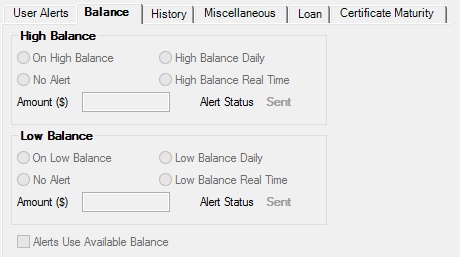Navigation: Internet and Phone Systems Screens > User Profile Screen > Accounts tab > Alerts tab >
Use this tab to view and indicate criteria for sending alerts to the web user account selected in the Accounts list view when account balance conditions occur on deposit accounts. Information can be set for both a High Balance Amount and Low Balance Amount.
This information can be indicated for Personal/Company users (if the Accounts tab is accessed from the main User Profile screen) or Sub-Users (if the Accounts tab is accessed from the Sub-Users tab).
Default values for these fields are set on the Internet and Phone Systems > Setup > Alert Defaults screen.

Internet and Phone Systems > User Profile > Accounts > Alerts Tab, Balance Tab
If your institution does not want to set a high and/or low balance condition for user alerts, mark the No Alert radio button in the necessary field group.
The other radio buttons in the field groups allow your institution to indicate how balance alerts are handled by the system:
•On High/Low Balance (mnemonic AKAOHB/AKAOLB): One alert is sent when the account becomes equal to/greater than the high balance Amount (mnemonic AKBALH) or equal to/lower than the low balance Amount (mnemonic AKBALL). This alert is sent only once until the account balance falls back beneath the high balance Amount or above the low balance Amount.
•High/Low Balance Daily (mnemonic AKHBDA/AKLBDA): An alert is sent when the account becomes equal to/greater than the high balance Amount or equal to/lower than the low balance Amount. This alert is sent daily until the account balance falls back beneath the high balance Amount or above the low balance Amount.
•High/Low Balance Real Time (mnemonic AKRTHB/AKRTLB): An alert is sent immediately whenever a transaction takes the account equal to/greater than the high balance Amount or equal to/lower than the low balance Amount.
Use the Alerts Use Available Balance field (mnemonic AKAUAB) to indicate whether balance alerts are based on the available balance of the account (as opposed to the current balance, which is the balance used if this field is left blank).